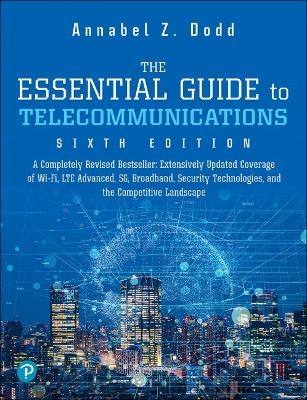
Essential Guide to Telecommunications, The
Pearson (Verlag)
978-0-13-450679-1 (ISBN)
– United States Senator Edward J. Markey of Massachusetts; Member, U.S. Senate Subcommittee on Communications, Technology, Innovation, and the Internet
“Annabel Dodd has a unique knack for explaining complex technologies in understandable ways. This latest revision of her book covers the rapid changes in the fields of broadband, cellular, and streaming technologies; newly developing 5G networks; and the constant changes happening in both wired and wireless networks. This book is a must-read for anyone who wants to understand the rapidly evolving world of telecommunications in the 21st century!”
– David Mash, Retired Senior Vice President for Innovation, Strategy, and Technology, Berklee College of Music
Completely updated for current trends and technologies, The Essential Guide to Telecommunications, Sixth Edition, is the world’s top-selling, accessible guide to the fast-changing global telecommunications industry. Writing in easy-to-understand language, Dodd demystifies today’s most significant technologies, standards, architectures, and trends. She introduces leading providers worldwide, explains where they fit in the marketplace, and reveals their key strategies.
New topics covered in this edition include: LTE Advanced and 5G wireless, modern security threats and countermeasures, emerging applications, and breakthrough techniques for building more scalable, manageable networks.
Gain a practical understanding of modern cellular, Wi-Fi, Internet, cloud, and carrier technologies
Discover how key technical, business, and regulatory innovations are changing the industry
See how streaming video, social media, cloud computing, smartphones, and the Internet of Things are transforming networks
Explore growing concerns about security and privacy, and review modern strategies for detecting and mitigating network breaches
Learn how Software Defined Networks (SDN) and Network Function Virtualization (NFV) add intelligence to networks, enabling automation, flexible configurations, and advanced networks
Preview cutting-edge, telecom-enabled applications and gear–from mobile payments to drones
Whether you’re an aspiring network engineer looking for a broad understanding of the industry, or a salesperson, marketer, investor, or customer, this indispensable guide provides everything you need to know about telecommunications right now. This new edition is ideal for both self-study and classroom instruction.
Register your product for convenient access to downloads, updates, and/or corrections as they become available.
Annabel Z. Dodd is on the faculty at Northeastern University's School of Professional Studies, where she teaches courses on data networks in the Master’s Degree Program in Informatics. She also presents seminars to organizations, worldwide. Her webinar on LTE Essentials for US Telecom attracted over 900 people.
Preface xvii
Acknowledgments xxi
About the Author xxiii
Part I: Fundamentals, Data Centers, and IP PBXs 1
Chapter 1: Computing and Enabling Technologies 3
Fiber-Optic and Copper Cabling 5
Chips–Building Blocks of the Digital Age 21
Packetized Data 23
Deep Packet Inspection: Monitoring, Prioritizing, and Censoring Traffic 26
Compression 30
Increasing Network Capacity via Multiplexing 37
Using Protocols to Establish a Common Set of Rules 40
Protocols and Layers 41
Virtualization: Space, Cost, and Maintenance Efficiencies 42
Managing Virtualization 44
The Cloud: Applications and Development at Providers’ Data Centers 47
Summary 62
Appendix 63
Chapter 2: Data Centers and LANs, Storage, and IP Private Branch Exchanges 67
Introduction 68
What Is a LAN? 69
Switches, Media, and Protocols in LANs 70
IP PBXs–Voice, Video, and Unified Communications 99
IP Telephony–Converting Voice Signals to Digital Data 101
Unified Communications, Contact Centers, and Video Conferencing 107
Appendix 118
Part II: Industry Overview and Regulations 123
Chapter 3: Competition, Industry Structures, and Regulations 125
Introduction 126
The 1984 Breakup of AT&T 128
Regulatory Issues 138
The State of the Industry–Consolidation via Mergers 149
Non-Traditional Competitors: Alphabet, Apple, Amazon, Facebook, Twitter, Snapchat, and Microsoft 156
Appendix 168
Part III: Managing Broadband Networks and Broadband Network Services 169
Chapter 4: Managing Broadband Networks 171
Introduction 172
The Public Network 173
Core Networks–Between Cities and Continents 175
Bandwidth Capabilities in Carrier Networks 187
Optical Transport Networks–Carrying Multiple Types of Traffic 191
Transporting Movies and TV in the Core 195
Middle-Mile Networks 197
Last-Mile Access Networks 199
Access Networks in Cable Operators’ Networks 209
Using Cable Modem Termination Systems for IP Traffic 211
Telecommunications Services in National Emergencies 217
Signaling 220
Appendix 224
Chapter 5: Broadband Network Services 227
Introduction 228
VoIP Calling Services over Broadband 231
Multi-Protocol Label Switching for Interoffice Connections 235
IP Virtual Private Networks over the Internet 238
Adding Security on Traffic Sent over IP VPNs 240
Managed Services 245
Digital Subscriber Line–Distance Limitations; Operates on Copper Cabling 247
Carrier Gigabit Ethernet 249
Network Topology on Dedicated, Private Lines 252
Appendix 266
Part IV: The Internet and Cellular Networks 269
Chapter 6: The Internet 271
Introduction 272
What Is the Internet? 273
Streaming–A Disruptive Technology 280
The Structure of the Internet 290
Security: Connected, Ubiquitous Networks–Vulnerable to Malicious Hackers 297
Privacy 306
The Impact of E-Commerce 308
Fostering Civic Participation and Engagement–Online Forums 309
Network Neutrality 311
The Digital Divide: Bandwidth, Skills, and Computers 315
Intranets and Extranets 317
Chapter 7: Mobile and Wi-Fi Networks 321
Introduction 322
Spectrum for Wireless Networks–A Critical Asset 323
More Efficient 4th Generation Digital Networks 333
LTE–The First True 4th Generation Cellular Protocol 336
5G Mobile Networks–Small Cells; Additional Capacity 359
The Internet of Things (IoT) 362
Applications and Services 366
Wi-Fi Standards, Architecture, and Their Use in Cellular Networks 368
Satellites–Geosynchronous and Low Earth Orbiting 380
Appendix 382
Glossary 389
Index 415
| Erscheinungsdatum | 12.08.2017 |
|---|---|
| Sprache | englisch |
| Maße | 180 x 230 mm |
| Gewicht | 700 g |
| Themenwelt | Schulbuch / Wörterbuch |
| Mathematik / Informatik ► Informatik ► Netzwerke | |
| Informatik ► Office Programme ► Office | |
| Technik ► Nachrichtentechnik | |
| ISBN-10 | 0-13-450679-0 / 0134506790 |
| ISBN-13 | 978-0-13-450679-1 / 9780134506791 |
| Zustand | Neuware |
| Informationen gemäß Produktsicherheitsverordnung (GPSR) | |
| Haben Sie eine Frage zum Produkt? |
aus dem Bereich


